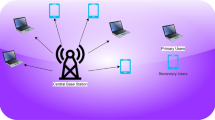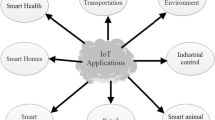Abstract
Designed for high data rate wireless personal area networks, the IEEE 802.15.3 medium access control (MAC) protocol fits well with emerging technologies like ultra-wideband. Peer discovery is essential in 802.15.3 piconets in which devices (DEVs) exchange MAC frames in a peer-to-peer manner. If two peer DEVs are unreachable, the standard peer discovery method will fail after unproductive backoff retransmissions, and a costly network layer routing is required. For DEVs uniformly distributed over the maximum coverage area of a piconet, such failures occur in up to 41.3% of intra-piconet peer discoveries. In this paper, we propose a novel third-party handshake protocol (3PHP) that provides more reliable and prompt peer discovery than the standard method. Especially, between directly unreachable DEVs within the same piconet, 3PHP replaces network layer routing by an efficient MAC layer forwarding that utilizes the available self-learning rate information to establish optimal routes. The mean peer discovery time for 3PHP is 100 μs lower than the standard method between directly reachable DEVs. More significantly, between directly unreachable DEVs within the same piconet, 3PHP has a much lower failure probability, and is up to 10 times faster than the standard method in establishing a peer-to-peer connection as the latter fails and network layer routing is invoked.
Similar content being viewed by others
References
Batra, A. et al. (2004, September) Multi-band OFDM Physical Layer Proposal for IEEE 802.15 Task Group 3a. IEEE P802.15-04/0493r0.
Bianchi, G. (2000, March) Performance analysis of the IEEE 802.11 distributed coordination function, IEEE Journal on Selected Areas in Communications, 18, 535–547.
FCC’s UWB first report and order, FCC02-48A1, Feb. 14, 2002.
IEEE 802.15 WPAN High Rate Alternative PHY Task Group 3a (TG3a), http://www.ieee802.org/15/pub/TG3a.html.
IEEE Standard 802.15.1 (2002, June) Wireless medium access control (MAC) and physical layer (PHY) specifications for wireless personal area networks (WPANs).
IEEE Standard 802.15.3 (2003, September) Wireless medium access control (MAC) and physical layer (PHY) specifications for high rate wireless personal area networks (WPANs).
Johnson, D. B., Maltz, D.A., & Hu, Y-C (2004, June) The dynamic source routing protocol for mobile ad hoc networks (DSR), IETF Internet draft.
Park, H. J., Kim, M. J., So, Y. J., You Y. H., & Song, H. K. (2003, May) UWB communication system for home entertainment network, IEEE Trans. Consumer Electronics, 49, 302–311.
Perkins, C., Belding-Royer, E., & Das, S. (2003, July) Ad hoc on-demand distance vector (AODV) Routing, IETF RFC 3561.
Porcino, D., & Hirt, W. (2003, July) Ultra-wideband radio technology: potential and challenges ahead, IEEE Communications Magazine, 41, 66–74.
Stroh, S. (2003, September) Wideband: multimedia unplugged, IEEE Spectrum, 40, 23–27.
Weisstein, E. W. Circle–Circle Intersection, from MathWorld—A Wolfram Web Resource, http://mathworld.wolfram.com/Circle-CircleIntersection.html.
WiMedia Alliance, http://www.wimedia.org/.
The Wireless USB Promoter Group, http://www.usb.org/wusb/.
Yin, Z., & Leung, V. C. M. (2005, June) Performance improvements of integrating ad hoc operations into infrastructure IEEE 802.11 wireless local area networks, Computer Communications, 28, 1123–1137.
Author information
Authors and Affiliations
Corresponding author
Rights and permissions
About this article
Cite this article
Yin, Z., Leung, V.C.M. Third-Party Handshake Protocol for Efficient Peer Discovery and Route Optimization in IEEE 802.15.3 WPANs. Mobile Netw Appl 11, 681–695 (2006). https://doi.org/10.1007/s11036-006-7795-8
Published:
Issue Date:
DOI: https://doi.org/10.1007/s11036-006-7795-8




